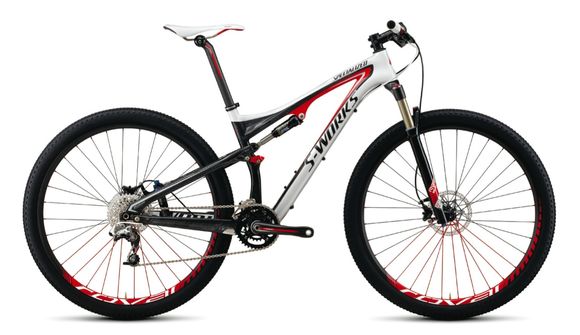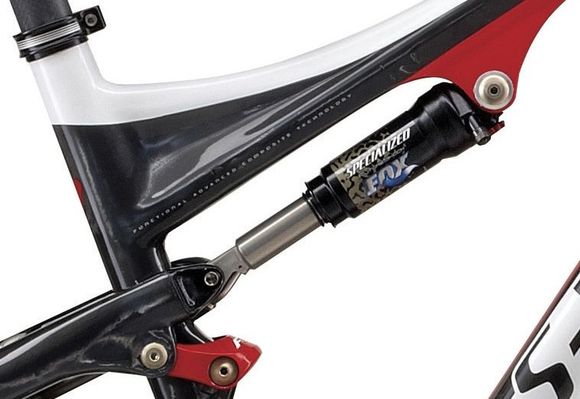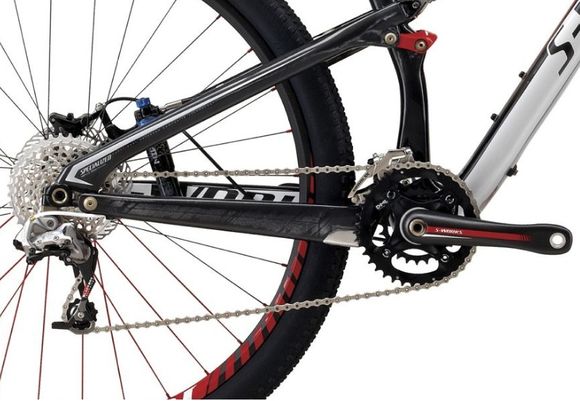
Before I tell you about the crop of hot new 2012 gear I saw at Interbike last week, I want to ruminate on the most decisive and exceptional product of 2011. I’ve been testing the Specialized S-Works Epic Carbon 29 for nine months, and I’m still impressed—sometimes even astounded—each time I ride it. Back in April, in the , I wrote, “This top-shelf race-ready 29er should end the debate over whether big wheelers are sluggish.” With more than a thousand miles on the bike, I’d go a step farther and say that I believe the Epic 29 may just be the final nail in the coffin for the 26-inch XC bike. Hear me out.
First, a quick review of the bike: This S-Works version of the Epic 29 is decidedly a race bike, with full carbon construction, sealed cartridge bearings at the pivots, and a replaceable derailleur hanger out back. A svelte custom RockShox SID World Cup fork and equally diminutive Fox-designed shock provide four inches of cushion front and rear. Both suspension units employ Specialized’s proprietary Brain sensors, which astutely distinguish small bumps and rider-induced bob from real hits so that the suspension stays locked out when you want rigidity but activates as soon as you hit large obstacles. Drivetrain and braking duties are taken care of by SRAM’s top-spec XX components, while wheel duty goes to Specialized’s Roval Control SL wheels, carbon hoops that are one of the bike’s finest attributes. It’s a first-rate list of parts that’s even more impressive when taken as a whole: My medium test bike weighed a paltry 22.1 pounds complete, minus pedals.
Light is great, especially for racing, but the real question is whether it all adds up to a good ride. If you’re looking for an efficient, thrilling cross-country bike, the answer is—definitively—yes. With a 70.5-degree head tube and relatively short, 44.8cm seat stays, the Epic 29 feels appropriately tight and racy, though the 90mm stem and surprisingly compact cockpit mean it’s not a painfully aggressive position out of the box. The first thing you notice when you start pedaling is how responsive the bike is; the combination of the Brain-actuated lockout and superlight weight make for explosiveness that rivals a road bike. Whether I was grinding up loose singletrack or churning fire roads out of the saddle, I could feel my output pushing me forward not being lost in pedal bob or on the rough trail.

You cannot overstate the significance of the bike’s Brain feature, which has been around for some years but has been tweaked to its finest iteration this season. As promised, the suspension engaged when I needed it, through rock gardens or over large steps, but stayed rigid and efficient otherwise. Of course you can mimic this on other bikes by constantly locking and unlocking the suspension manually. But by automating the process, the Epic takes away the effort of having to think about it, ensures that it happens consistently (how many times have you jangled down the first bit of a descent because you forgot to turn on the fork?), and makes for a safer ride by letting you keep your attention on the trail instead of your lock-out knobs. Far from as simplistic as on or off, however, the fork felt relatively supple in small bumps and the rear end stayed active and engaged on chattery climbs. One niggle: Because of the way the Brain engages, the suspension sometimes has a distinct clunk as the rear end returns to neutral position after a hit. This doesn’t affect performance, but some riders may find the sensation rough.
The Epic proved just as deft on descents as it did climbing. Though it’s not plush like a trail bike, the four inches of suspension was plenty for me to open up the brakes and let the bike fly. Even in rock gardens and scree, if I was daring enough to let the bike roll it would plow right through. I occasionally bottomed the suspension on three-foot steps or bigger, but I felt the combination of the big wheels and suspension handled the rough terrain as well as can be expected from a bike this size. And on smooth descents the Epic carved as straight and fast as rigid frame, with the front end slicing the turns and the rear end fully tracking.
Credit, in part, the Roval wheels: The rigidity of the carbon let me push the bike into turns as hard as I wanted without the wheels budging. The carbon hoops are part of why this bike is so wildly expensive. But the performance bump is worth the money, especially in the 29er platform, where you reap the benefits of the feathery weight going up and the stiffness when pointing down. The other contributing factor to the bikes blazing accuracy downhill is Specialized's new 142+ rear axle, which puts the hub bearings as outboard on the spindle as possible to add even more stiffness. One surprise, however, is that the RockShox Reba fork didn’t get a similar treatment. Clearly Specialized went with a standard 9mm quick release to save grams, but I would rather see a 15mm through-axle front hub, which would make the bike that much more sure-footed and direct on hard descents.
I had just a few other minor quibbles, most notably the brakes. While the SRAM XX brakes are some of the lightest on the market, they proved disappointingly inconsistent. On delivery, they were mushy and faded on the trail, and though a brake bleed fixed that, the problems returned after less than 100 miles of riding. This inconsistent performance characterized the entire test period, with stopping power varying from hair-trigger sensitivity to levers-to-the-bar soft, often swinging back and forth multiple times in the same ride. SRAM acknowledged some irregularity in this year's product and told me that the entire lever assembly has been redesigned for 2012, but it was still disappointing to have such fickle performance from such a high-end part. The Epic's other achilles heel was the Specialized Renegade tire. Admittedly this is lightweight racing rubber for rolling fast, but I was still surprised to rip out the sidewall casings on three separate tires in less than a month. If you live anywhere with rocks, you'll want to switch to something beefier.

Nitpicking aside, the Epic proved itself repeatedly in a myriad of venues and conditions. Last weekend, I raced it at the , an overnight, high-altitude marathon of huge climbs and hairy descents, and in spite of wheel-eating terrain, it cruised the maw. This weekend I ran it at a local enduro event called the , and though it was muddy, wet, and slick, the drivetrain shed the elements like a slicker and was still shifting great by day's end. On the final descent into Taos, a scraggly, very steep, rock-studded singletrack, I slammed through the rough at wicked speed and never once felt out of control. Every time I took it to a race, riding the Specialized felt like brandishing a stealth weapon, almost to the point that it felt like cheating. And in case you're not convinced by my mediocre prowess, Jaroslav Kulhavy silenced detractors who said 29ers weren't capable at this level of riding when he won a World Cup in May and the earlier this month aboard this very bike.
Finally, I want to return to my assertion that the Epic 29er will be the bike to slay the XC 26er. In addition to the 29er, I had an S-Works Epic Carbon 26er to test, and I rode the two bikes on many of the same courses, often back to back on the same day. The smaller-wheel bike is plenty fun to ride, but not only was I invariably more comfortable on the 29er, I was also consistently faster. Obviously there are many factors—style of riding, terrain, personal preferences—and I'm not claiming any scientific certainty. All I can say is that in nine months, I didn't find a single situation where I preferred the 26er to the 29-inch Epic.
No review of the S-Works Epic 29er can overlook the bike's exorbitant price. At $9,900, it is largely a showpiece ride for sponsored racers—or so I thought until I was at the Leadville 100, where scores of average riders were aboard this rig. By my estimation (and lots of other's judging by that race), this is the finest cross-country bike that money can buy, but if you can't bring yourself to cough up more for a bike than for a good used car, there are options. Three 29ers deliver the same carbon frame as the top-end bike (albeit in a slightly heavier lay-up than the S-Works version) with lesser components, meaning you can get many of the same perks for between $4,300 and $5,200.
The S-Works Epic 29er is a turning point as it's the first 29er to remove all the penalties of riding big wheels and deliver only the advantages. Light, quick, stiff, and strong, it is the 29er that we've all been waiting for. And judging by what I saw at InterBike for next season and beyond, it heralds things to come.
–Aaron Gulley